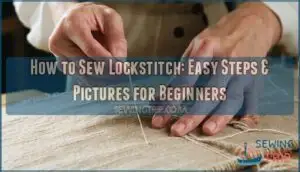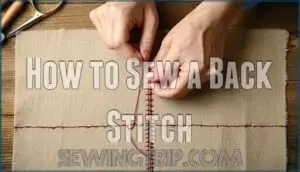This site is supported by our readers. We may earn a commission, at no cost to you, if you purchase through links.

Start by threading your needle and knotting the end. Insert the needle from the front of your fabric, then bring it back up about 1/8 inch ahead.
Now here’s the key: insert your needle back into the original hole, creating a small backward loop. Pull the thread snug but not tight.
Continue this pattern, always going back into the previous stitch before moving forward. This creates interlocking stitches that hold firm under stress.
The technique works perfectly for seams, hems, and repairs where durability matters most. Master this fundamental stitch and you’ll discover stronger hand-sewing techniques.
Table Of Contents
Key Takeaways
- Master the backward-loop technique – You’ll insert your needle back into the original hole after moving forward, creating interlocking stitches that won’t unravel under stress.
- Choose polyester thread for best results – You’ll get superior strength, colorfastness, and flexibility compared to other thread types, with 40-60 weight being ideal for most projects.
- Use lockstitch for durability over decoration – You’ll create stronger seams than backstitch by interlocking threads inside the fabric rather than overlapping on the surface.
- Practice consistent spacing and tension – You’ll achieve professional results by keeping stitches evenly spaced at 1/8 inch intervals and maintaining snug but not tight thread tension.
Sewing Lock Stitch Tutorial
You’ll learn to create strong, professional seams with lockstitch in just a few simple steps.
This technique uses two threads that lock together inside your fabric, making it perfect for most sewing projects.
Lockstitch Vs Backstitch
When choosing between lockstitch and backstitch, you’re picking between two powerhouse hand sewing techniques that secure seams differently.
Lockstitch creates small knots at each stitch point, while backstitch overlaps into previous stitch holes for continuous strength.
Here’s what sets them apart:
- Strength comparison: Backstitch wins for long seams, lockstitch excels at reinforcing specific points
- Thread consumption: Lockstitch uses less thread than backstitch’s overlapping method
- Appearance differences: Lockstitch creates neat dots, backstitch forms visible dashed lines
For seam security, both techniques prevent unraveling effectively. Hand vs. machine application varies – machine lockstitch produces nearly invisible seams, while hand lockstitch gives raised texture.
Your lockstitch tutorial journey starts with understanding these fundamental differences between sewing techniques. Most modern machines utilize the lockstitch mechanism as their standard stitch.
How to Sew Lock Stitch, Step by Step Instructions
The lockstitch tutorial starts with proper setup. Thread your needle with polyester thread for best results. Place fabric under your presser foot.
For Hand Lockstitch, begin with a foundation row of vertical stitches. Push the needle through each stitch alternately. Keep thread above then below for cable-style interlocking.
Machine Lockstitch requires Threading Needle from above and bobbin below. Lower the needle into fabric for Fabric Placement. Move forward while stitching. Use reverse button at start and end for Securing Seams.
A variety of options are available for lockstitch sewing machines. This lockstitch technique creates strong seams without bulk on sheer fabrics.
Advantages of a Lock Stitch
Master craftspeople know that choosing the right stitch makes all the difference. Lockstitch delivers unmatched Seam Durability and Professional Finish that stands the test of time.
The lockstitch mechanism utilizes a hook to loop the upper thread.
Here’s why lockstitch beats other stitch types:
- Prevents Unraveling – Interlocked threads create secure seams that won’t come apart
- Fabric Versatility – Works on everything from silk to denim with your sewing machine
- Reduced Bulk – Clean finish maintains natural drape without added thickness
This fundamental sewing basics technique offers superior Seam Security for lasting results.
Best Thread for Lock Stitch
Your thread choice makes or breaks your lockstitch success. Polyester thread delivers the best results for most projects. It resists shrinking and fading while providing excellent strength.
| Thread Material | Best For | Key Benefits |
|---|---|---|
| Polyester | General sewing | Strong, colorfast, flexible |
| Cotton | Natural fabrics | Traditional look, heat resistant |
| Silk | Delicate work | Smooth finish, elegant appearance |
Thread weight matters too. Use 40-60 weight thread for standard lockstitch projects. Lighter fabrics need 60 weight thread. Heavier materials like denim work better with 30 weight thread.
Match your thread color to your fabric for invisible seams. Choose thread that complements your fabric type for best fabric compatibility. Quality thread prevents skipped stitches and guarantees your sewing machine runs smoothly. Different stitch types require different threads, but polyester works well for most lockstitch applications.
Sewing Machine Lock Stitch (Automatic Lock Stitch)
Modern sewing machines make lockstitching effortless with their automatic lock stitch feature.
Automatic lockstitch technology revolutionizes home sewing with precision that rivals professional equipment.
This computerized function creates tiny, secure stitches at seam beginnings and ends without manual backstitching.
Your machine handles automatic tension adjustments and stitch length control for consistent results across different fabrics.
**Lock stitches offer improved stitch durability, making them ideal for various projects.
Here’s what makes automatic lockstitch amazing:
- Perfect seams every time – No more worrying about loose threads or unraveling edges
- Professional results instantly – Even beginners create expert-quality finishes
- Time-saving magic – Complete seams faster than traditional hand methods
- Stress-free sewing – Let your machine do the technical work while you create
- Consistent quality – Every stitch matches perfectly for polished projects
Choose appropriate needle types for your fabric weight.
Regular machine maintenance prevents troubleshooting issues and keeps your automatic lock stitch working smoothly.
Embroidery Lock Stitch
When you’re ready to add visual flair to your hand embroidery projects, the embroidery lockstitch creates stunning decorative borders with remarkable definition.
This technique weaves thread over foundation stitches to produce raised, cable-like effects that won’t unravel easily.
Start by creating a row of straight foundation stitches spaced 5mm apart. Thread your needle under the first stitch, keeping the working thread above it. For the next stitch, pass under while keeping thread below. Continue alternating this pattern without piercing the fabric during the weaving process.
| Aspect | Recommendation | Why It Works |
|---|---|---|
| Thread Variations | Polyester or mercerized cotton | Superior durability and smooth finish |
| Fabric Choice | Fine fabrics, sheer materials | Prevents bulk and maintains drape |
| Stitch Tension | Keep foundation loose, lacing snug | Creates even profile without puckering |
This hand embroidery stitch excels in decorative applications like borders, monograms, and pattern design elements. The raised profile separates design components visually, making your embroidery pop with professional-looking results that resist wear. For more intricate designs, consider exploring different types of embroidery stitches to enhance your project.
How to Sew a Back Stitch
While embroidery lock stitch creates decorative patterns, backstitch offers superior durability for structural sewing.
You’ll find backstitch uses extend beyond simple seams—it’s your go-to for reinforcing stress points and creating lasting connections.
This fundamental technique predates modern sewing machines, proving its reliability through centuries of use.
Backstitch appearance differs from lockstitch because each new stitch overlaps the previous one, creating a continuous line.
Here’s how backstitch history shaped today’s sewing:
- Backstitch durability surpasses basic stitches since overlapping creates triple-layer reinforcement at connection points
- Needle and thread positioning requires precise backward motion—you’ll stitch behind your starting point before moving forward
- Backstitch alternatives like running stitch lack the same holding power, making backstitch essential for permanent seams
This technique transforms loose fabric edges into secure, professional-looking seams that won’t unravel under stress.
Frequently Asked Questions (FAQs)
How do you sew a lock stitch?
Like threading a needle through fabric’s heart, you’ll create lockstitch by interlocking upper and lower threads.
Start with straight stitches, then alternate placing thread above and below each foundation stitch for secure interlocking.
What is lock stitch sewing?
Lock stitch creates strong, durable seams by interlocking upper and lower threads inside fabric.
You’ll thread your needle from above while the bobbin provides thread from below, forming secure connections that won’t unravel easily, which helps create a durable seam.
How do you secure a lock stitch?
You’ll secure lockstitch by creating tiny forward stitches at seam ends instead of backstitching. This prevents bulk while locking threads naturally. The interlocked threads won’t unravel when you trim excess.
Can you sew a lock stitch on a sewing machine?
Need maximum precision in your stitching? Yes, you can absolutely sew lockstitch on a sewing machine.
Set your machine to straight stitch, thread properly, and start stitching.
The needle and bobbin threads interlock inside the fabric, creating strong, durable seams perfect for garments.
What is a lockstitch in sewing?
A lockstitch interlocks your top needle thread with the bottom bobbin thread inside fabric layers.
You’ll create strong, durable seams that won’t unravel easily.
This fundamental technique forms the backbone of most garment construction.
When do you use a lock stitch?
You’ll reach for lock stitch when creating professional seams on garments, sewing darts in fitted clothing, working with sheer fabrics, or hemming heavy items like curtains and drapes.
What Type of Needle Should I Use for Lock Stitch?
Don’t put all your eggs in one basket with needle choices.
Crewel needles sizes 1-12 work best for lock stitch. These needles handle the thread interlocking smoothly.
You’ll also need a tapestry needle for securing final threads.
What is the Difference Between Lock Stitch and Back Stitch?
Lock stitch interlocks two threads inside fabric for strength, while back stitch overlaps previous stitches on the surface.
You’ll find lock stitch creates neater, less bulky seams using tiny securing stitches instead of backstitch’s three-layer endings.
What Types of Fabrics Are Best Suited for Lock Stitch?
Ninety percent of sewers choose lockstitch for woven fabrics.
You’ll get best results with cotton, linen, silk, and wool.
These materials hold the interlocked threads securely.
Avoid stretchy knits since they need specialized stitches instead.
How Can I Make a Lock Stitch Look More Decorative?
You can make lock stitch decorative by using contrasting thread colors, varying stitch spacing for pattern effects, or combining with embroidery techniques.
Try metallic threads or create intentional texture variations to transform functional stitching into beautiful design elements.
Conclusion
Mastering how to sew lockstitch transforms your needlework from pioneer-era repairs to professional-quality seams.
You’ve learned the backward-loop technique that creates interlocking threads. This method strengthens fabric joints beyond basic running stitches.
Practice on scrap fabric first. Your lockstitches will hold firm under washing and wear.
Remember to maintain consistent spacing between stitches. Keep thread tension snug but not tight. With these skills, you can tackle complex sewing projects confidently and create lasting repairs.
- https://www.chinapackstar.com/news/how-does-a-lockstitch-sewing-machine-work-71988255.html
- https://www.youtube.com/watch?v=Og1hM8iS22Q
- https://digitalcommons.usu.edu/cgi/viewcontent.cgi?article=2695&context=extension_curall
- https://leatherworker.net/forum/topic/43097-machine-lock-stitch/
- https://www.reddit.com/r/vintagesewing/comments/zcoucw/how_do_i_start_a_seam_so_that_it_wont_unravel/







